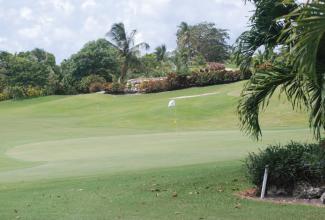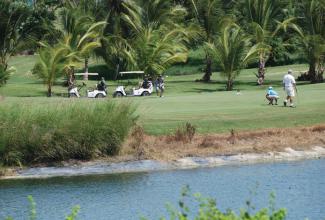“Sustainability is something that we take very seriously.” This affirmation comes from the Project Manager at the Apes Hill Golf Resort and Community, Donovan Bagwell, as he describes the major undertaking of redesigning the 18-hole Championship golf course. Apes Hill Barbados is not just building another green; they’re building an eco-system, a community rooted in sustainability which positively impacts the course and residents of the ultra-luxury resort.
First, let’s talk golf.
The Jaw-Dropping Wow Factor at Apes Hill Barbados
The redesign of the course began in 2019. Despite this being an unprecedented period of pandemic and uncertainty, full steam went ahead in stripping the course down to dirt for a total renovation. It’s been a blessing in disguise to build back better, with every effort to place sustainability at the fore.
Leading the redesign was one of the most experienced golf course architects in the world, Ron Kirby, and two of the finest land shapers in the business, Justin Carlton and Gary Shapiro. Initially, the previous golf course architecture was analysed with one conclusion drawn: it needed a wow factor.
Their teamwork allowed Apes Hill Barbados to work intimately with mother nature, highlighting the course’s unique, natural indigenous assets to provide the most memorable golfing experience in the Caribbean.
A Place of Natural Heritage
Roddy Carr, who coordinated the golf project, sums up the focus of the redesign succinctly: “The key focus is to make golf at Apes Hill the most enjoyable golfing experience in the Caribbean. This means softening the golf course considerably by reducing the slopes on greens...and accentuating all the natural assets of the 475-acre site.”
In terms of natural assets, Apes Hill Barbados has an elevated vantage point of nearly 1,000 feet above sea level, straddling both the east and west coasts. From the front 9, you have views to the sparkling Caribbean Sea. From the back 9, you are entrenched in spectacular vistas over the wild Atlantic east coast; deep, winding gullies, indigenous forests, and rock formations of the Scotland District. This district is critical in Barbados’ history: the area is part of an underwater mountain range that emerged from the ocean millions of years ago. It’s geology is therefore vastly different from the rest of the island, which was formed through tectonic movement.
Natural history this significant deserved a spotlight, and that’s what the redesign brought to the course.
As you putt around from hole to hole, you’ll also pass vibrant patterns of tropical plants and fruit trees. Breadfruit trees, coconut trees, banana trees, coffee, lime trees, agave patches. Not to mention the fluttering pollinators like butterflies and hummingbirds. There are creatures of all sizes calling Apes Hill Barbados home, from osprey and egrets to families of green monkeys popping in and out of view to see if you can make a birdie.
Good Golf Depends on Good Grass
Even a non-golfer would imagine that maintaining turf grass usually requires an enormous amount of water, fertilizer, and pesticide. But at Apes Hill Barbados, meticulous research led to the selection of an insect-resistant, low-water-consumption Zorro Zoysia grass. This means that the course requires a smaller volume of water and chemical pesticides to maintain it.
“We’re trying to build something that is here forever,” says Ed Paskins, Golf Course Superintendent at Apes Hill Barbados Golf Resort and Community, in simple summary of the mission to “grow good grass”.
“We were very careful with the design to focus on reducing the footprint of the grasses that need full maintenance, water and fertilizers.” Ron Kirby adds. “The new Zoysia Zorro grass we planted needs less water.”
In fact, the golf course turf at Apes Hill Barbados is irrigated by 100% rainwater. This rainwater reservoir is located in a farmland area, holding 58 million gallons which are pumped into an 8 million gallon reservoir on the stunning 16th hole. Thanks to ground-breaking initiatives like these, the golf resort is on trajectory to become the most environmentally responsible course in the Caribbean.
Environmentally Conscious Construction
Water preservation techniques are also used across the residences. The architecture of the ultra-luxury resort homes embraces sustainable modern practices. For instance, the Hilltop neighbourhood features a bioswale network designed to concentrate and convey stormwater runoff while removing debris and pollution, beneficially recharging the groundwater.
The homes in the Apes Hill Barbados Golf Resort and Community have been designed to encourage natural ventilation, through the thoughtful siting of the homes and the arrangement of windows and doors, minimizing the reliance on air conditioning. Energy efficiency has also been taken into consideration with the introduction of variable speed pumps, LED lighting and energy star rated kitchen appliances. Homes can also benefit from photo voltaic electrical generation and electric golf cart and vehicle charging ports.
Golf Performance and Teaching Centre
Golfers will appreciate discovering the Performance and Teaching Centre, with state-of-the-art Titleist Performance Institute and PuttView technology, the first one to open in the Caribbean.
There is also a Par 3 course measuring around 1100 yards long in total, designed for all levels of golfers, young and old, to enjoy and have fun together in a casual atmosphere. You can upgrade your golf gear at the pro shop.
But, these golfing extras are just the bells and whistles; it’s Apes Hill Barbados’ down to earth dedication to sustainability and elevated resort experience that truly makes it rewarding.



